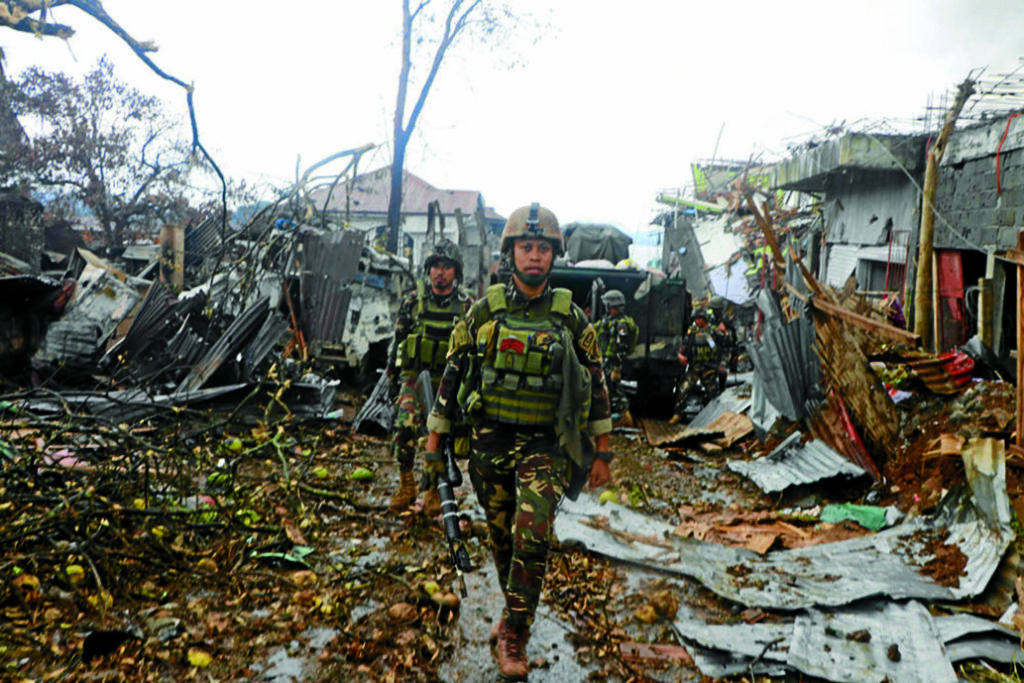IS threat remains high in PH – Aon study

Soldiers march into an area of Marawi they had overtaken from the Maute group in this undated photo released by the Philippine Army.
ARMY PHOTO
The jihadist movement under Islamic State (IS) is seen to pose sustained threat to Southeast Asia and the risk remains “high” in the Philippines, where an affiliate local group had wreaked havoc in the southern city of Marawi last year.
This is according to the 2018 Risk Maps covering Political Risk and Terrorism and Political Violence, produced by global professional services firm Aon in conjunction with Continuum Economics and The Risk Advisory Group.
Despite the absence of a spectacular attack by IS in Southeast Asia in 2017, the movement and their affiliates are seen to pose a sustained threat as IS has “provided a unifying framework for groups in the region, binding them together into a more coherent and capable force,” the report said.
The report said Singapore could be a “prized target,” noting several propaganda pieces specifically aimed at the city-state in 2017. The country risk level for Singapore remains “low” a year after it was raised from “negligible” but a terrorism peril is still in place, particularly from attacks mounted by lone actors using improvised weapons, the report said.
The terrorism threat is seen to be “more severe” in the Philippines where overall country score remained “high” this 2018, a year after it was raised from “medium”. This comes after Islamist extremists seized control of Marawi for five months in 2017, promoting the government to declare martial law.
Article continues after this advertisementThe Marawi attack indicated that IS-linked factions were regrouping in southern Philippines and there was jihadist capability to mount attacks from there across Southeast Asia, the report said.
Article continues after this advertisementDan Bould, Asia regional director for crisis management at Aon Risk Solutions, commented: “In 2018, we expect a continued increase in terrorist activity within Asia. While the global reach of IS appears to have peaked, they will continue to agitate for attacks in areas where they have traction, notably in the Philippines and to a lesser degree in Malaysia, Indonesia and Singapore.”
“Recently we have seen IS producing more directed and relevant propaganda content aimed at Asia based militants and affiliates. Their messages aim to inspire and motivate individuals to mount attacks using crude and improvised weapons. The shift in modus operandi towards lone wolf attacks utilizing everyday objects highlights an evolving peril that organizations must address. The property damage sustained in such an attack is historically minor while the effect on operations and business interruption may well be substantial,” he said.
Globally, IS mounted terrorist attacks in 29 countries on five continents in 2017, the same number of countries as in 2016 and up from 19 countries in 2015. The number of terrorist attacks in Western countries in 2017 (204) was roughly double that of 2016 (96).
In particular, the report said that the tourism sector would have to manage the risks posed by increased terrorism, with the sector a highly attractive target. In 2017, there were at least 35 attacks worldwide that directly targeted critical commercial components of the tourism industry, such as hotels and resorts, nightclubs, civil aviation and visitor attractions.
Over the last year, the report noted that trade linkages of Asian countries have been shifting away from the US and toward China. The ongoing trade standoff between the United States and China – now fuelling fears of a full-blown trade war – is also seen to upset the growth trajectory of Asian nations if not managed well.